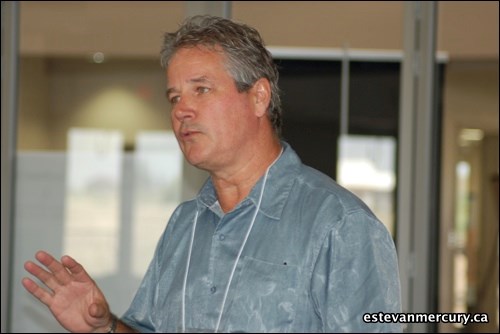Noted immunologist and director of the Canadian Centre for Health and Safety in Agriculture, Dr. John Gordon, was one of the guest presenters at the Southeast Saskatchewan Airshed Association workshop in Estevan on June 6.
Gordon, who will be a co-leader of a respiratory data-gathering project in Estevan and Swift Current that will begin later this summer, is a University of Saskatchewan professor with a Harvard Medical School background in lung and airway infections.
The airways research group will study air contaminants in the two cities, building on information gathered a few years ago in these same two cities by another U of S doctor, Donna Rennie who gathered data from school-aged children.
This time around, the 100-person sample groups in Estevan and Swift Current will be aged 50 to 70 and they will be a part of a two-year process that will provide vital information for detailed analysis on respiratory questions.
Gordon told the delegates attending the workshop that was held in the Saskatchewan Energy Training Institute, that dust collects on surfaces and it, in turn, collects other components found in the air that cause the problems in society.
"There is clean dust and then there is dust that things stick to," he said. "Pesticides, for instance, can piggyback on dust, so what happens to that dust that gets into the lungs? That's what we're going to find out."
Gordon will be the co-leader of the project with Dr. Don Cockcroft, also from the U of S, and they will lead an impressive team containing experts in other areas of medical and scientific research.
They will be calling on data collected between 1994 and 2005 when it was determined that the incidence of asthma in Saskatchewan went up 45 per cent. He said Dr. Rennie's findings showed respiratory weaknesses in female students in Estevan at a rate of 21.4 per cent compared with 16.2 per cent in Swift Current. He said it was noted at the time that Swift Current's environment was mostly agriculture with a bit of oil industry residue, while Estevan's was more complex with industrial, agriculture, coal, oil and other components affecting the results.
The baseline group of 50-to-70-year-olds will be asked to keep daily diaries and peak expiratory measurements will be recorded while the researchers carry out their dust analysis and test inflammatory activity on the lung cells and bacterial endotoxins. Animal models will also be used as part of the study.
Gordon said a modest grant of $100,000 per year has been received and it will be matched by a $30,000 grant from the U of S to conduct the study. Due to the financial limitations, the scope of the project had to be reduced. The U of S researcher said the original plan was to include a baseline sample group of citizens from Lloydminster as well, but that component had to be eliminated when the money wasn't forthcoming. "But we'll still limp along and get our information from Estevan and Swift Current for sure," he said.
The preliminary data collected years ago by Rennie and others will be used to full advantage by the latest team, he said.
Changes in dust density in Estevan will be noted and the National Laboratory will be called upon to provide their resources once the research is completed and the analysis and results are to be tallied.
Gordon later told The Mercury that during the two-year study, the data collected will be followed closely to note the seasonal changes.
"There is so much that could be done, but the budget limits it, but maybe heading into the second year, or after the second year we'll find a larger pot of money," Gordon said. "We'll still get valid data."
The U of S professor explained that by using an older group of citizens this time around, they'll be able to provide a clinical perspective to the study.
"This might be a better group and it won't skew the data. We'll be able to see the effects on their health and certain conditions may already have started."
Gordon said the research team will be looking for local candidates by August of this year.




